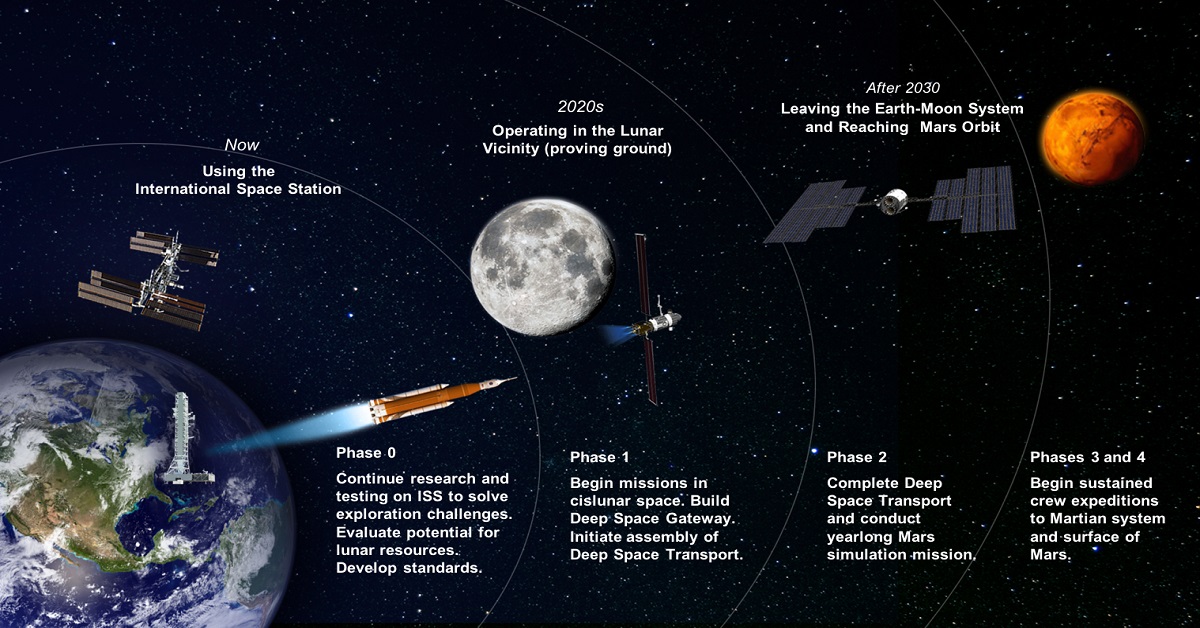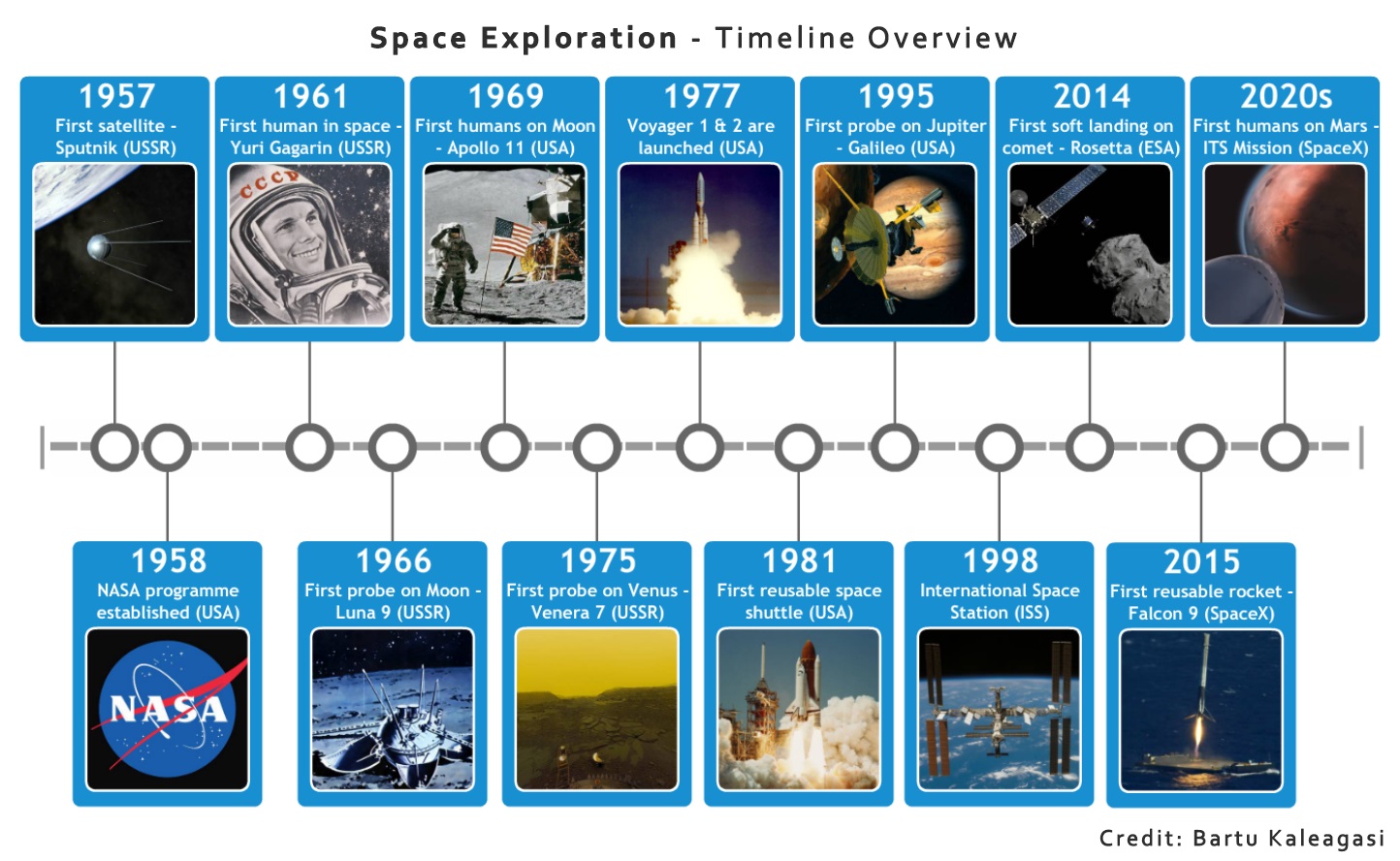
It was a time when it was not possible for humans to cross the sea or the ocean, but today in the 21st century the scientific development of humans has reached the search of the universe, which is incredible in you. Space travel or space exploration and the discovery of the universe and its exploration is done by the use of space technologies and human space flights and robotic space.
List of Space Exploration Missions:

The following is the world's exploration missions are discussed:
1. Luna Program:
It was a series of unmanned space missions of the Soviet Union sent to the moon between 1959 and 1976. It was designed as an orbiter or Lander.
2. Project Apollo:
This was a series of human space-light missions conducted between 1961-1972 by the United States using the Apollo space shuttle and Saturn Launch Vehicle. In 1961, this third American human space program, which was first to fly by two-person project Gemini to increase the spaceflight capacity in support of Apollo. Prior to this mission, Neil Armstrong, Michael Collins and Buzz Aldrin were part of the space campaign. Neil Armstrong was the first person to walk on the moon.
3. In October 1960, the Soviets sent two flyby space exploration vehicles under the space program called Mars 1960A and Mars 1960B, but both failed to reach Earth's orbit.
4. NASA's Jet Propulsion Laboratory has made two attempts to reach Mars. Mariner 3 and Mariner 4 were the same spacecraft designed to drive the first flyby of Mars. Mariner 4 was successfully launched on 28 March 1964 on the eighth month of the Red Planet.
5. Viking Program:
NASA had run this program in 1975 and used the spacecraft named Viking 1 and Viking 2 in this mission. Both of the spacecraft had entered the orbit of Mars and each had released a Lander module so that successful landing on the surface of Mars could be successful in the future.
6. The Phobos Program:
This was an unmanned space mission by the Soviet Union which was sent to study Mars and its moon Phobos and demos.
7. Mars Global Surveyor:
This is the first such mission in two decades which has been completely successful, which was launched on November 12, 1997, for the study on Mars. The Mars Global Surveyor completed its primary mission on January 31, 2001, and is now in an extended mission phase.
8. Mars Pathfinder:
This space shuttle landed on July 4, 1997, in the Northern Hemisphere in the Northern Hemisphere, on the field of an ancient flood named Ares Wallis. It established a small remote-controlled rover named Sozoraner on Mars, whose main goal was to travel a few meters around the landing site, discover nearby conditions and sampling rocks.
Do you know which planet of our solar system is the most gravitational force?
9. Mars Odyssey:
This is a robotic spacecraft orbiting the Mars Planet developed by NASA. It was originally a component of Mars Surveyor 2001 program, and it was named Mars Surveyor 2001 orbiter. Its purpose was to be a partner spacecraft to be known as the Mars surveyor 2001 Lander, but after the failure of Mars Climate Orbiter and Mars Polar Lander in late 1999, the Lander mission was canceled in May 2000. After this, 2001 Mangal Odyssey's name was chosen as a special tribute to the approach of space exploration.
10. Mars Express:
This is a space exploration mission organized by the European Space Agency, which is currently searching on Mars and is the first planetary mission to be tried by the agency. "Express" basically refers to speed and efficiency. This spacecraft includes the MERS Express Orbiter and Lander Beagle 2.
11. Mars Exploration Rovers:
It was launched by NASA for search on Mars. It successfully landed on Mars on January 3, 2004, at the place called Gusev Crater.
12. Mars Reconnaissance Orbiter:
It was sent for a scientific survey on Mars on August 12, 2005, for two years.
13. Venera Mission:
It was a series of investigations that was developed by the USSR to collect data from Venus. To enter the other planet's atmosphere; To land on another planet; It was the first man-made device to return images from the surface of the planet and to study high-resolution radar mapping of Venus.
14. Vega program:
It was a series of unmanned spacecraft missions launched in December 1984 in a cooperative effort between the Soviet Union and Austria, Bulgaria, France, Hungary, the German Democratic Republic, Poland, Czechoslovakia and the Federal Republic of Germany.
15. Venus Express:
This is the first Venus Exploration Mission of the European Space Agency.
16. Magellan Spacecraft:
This was a robotic spacecraft, which was started by NASA on May 4, 1989, to measure the surface mapping and planetary gravity using the synthetic aperture radar. Its name was named after the 16th-century Portuguese explorer Ferdinand Magellan. This was the first planetary spacecraft to fly by shuttle Atlantis from Florida's Kennedy Space Center.
17. Pioneer Program:
It was an unmanned space mission for planetary discovery.
18. Mariner program:
It was a 10-mission program organized by the American Space Agency NASA with Jet Propulsion Laboratory (JPL). It was created to investigate Mars, Venus, and Mercury.
19. Voyager program:
It is an American scientific program to study external solar systems.
20. Zond Program:
It was a series of Soviet unmanned space programs for the investigation of 3 MV planets from 1964 to 1970, which aimed to gather information about the surrounding planets.
21. Dawn Mission:
In September 2007, NASA launched it to study the three known protoplanets of the asteroid belt, Vesta and Ceres. It was retired on November 1, 2018, and is currently in an uncontrolled class about its second goal, the dwarf planet Ceres.
22. Deep Impact:
This is a NASA space probe designed to study the structure of the interior of comet Temple 1.
23. Messenger (Mercury Surface, Space Environment, Geochemistry, and Ranging):
This was a NASA robotic spacecraft that was sent between 2011 to 2015 to study the chemical composition, geology and magnetic field of Mercury.
24. Rosetta:
It was launched in 2004 to study the non-unmanned space mission Comet 67 P / Churyuov-Garesimenko, led by a European Space Agency.
25. Hayabusa:
This is an unmanned space mission of the Japan Aerospace Exploration Agency, which analyzes samples from a small close material near the horizontal of the Earth for analysis of 25143 Itakawa (210 meters to 270 meters dimensions 540 meters) and analysis Was sent for.
26. Near-Shoemaker:
This is a robotic space designed by NASA for Johns Hopkins University Applied Physics Laboratory, which was created to study the asteroid ERO near the Earth.
27. Cassini-Huygens:
This is a joint NASA / ESA / ASI unmanned space mission aimed at studying Saturn and its moon.
28. Galileo:
It was the unmanned spacecraft NASA sent to study Jupiter and its moon.
29. Suisei (Planet-A):
To study the comet Heli is the spacecraft sent by the Japanese Space Agency which was launched from the Kagoshima Space Center on August 18, 1985.
30. Discovery program:
This is a low-cost space mission (compared to the New Frontier or Flagship programs) that was launched to search the solar system.
31. Chandrayaan Program:
It was India's first space shuttle to travel to the moon, under the lunar exploration program of the Indian Space Research Organization. An unmanned vehicle was sent to the moon on 22 October 2008 under this campaign and it was active till August 30, 2009. This vehicle was launched from Satish Dhawan Space Center with the help of a modified version of the Polar Satellite Launch Vehicle (Polar Satellite Light Vehicle Vehicle, PSLV). It took 5 days to reach the moon, but it took 15 days to set it in the orbit of the Moon. Chandrayaan's aim was to find detailed maps of the Moon's surface and parts of water and helium.
32. Mangalyaan Program:
India is the first Mars mission and is the mission between the first planets. In fact, this is an ambitious space project of the Indian Space Research Organization. Under this project, a satellite left for orbiting Mars on November 5, 2013, was released successfully by Satish Dhawan Space Center from Sriharikota, Andhra Pradesh, by Polar Satellite Launch Vehicle (PSLV) C-25.
The main goal of this mission is to develop the necessary design, planning, management and implementation of interplanetary space missions. The orbiter will be orbiting Mars with its five instruments and send statistics and photographs to the world to achieve the scientific purpose. At present, the space station is being monitored from the Space Control Center of ISRO Telemetry, Tracking and Command Network (ESTRAC), Bangalore, with the help of Indian Deep Space Network Antenna.
33. Chang's Program:
This is a continuous series of Robotic Moon Missions by the China National Space Administration (CNSA). In this program, the launch of launches, launchers, rovers and sample return spacecraft, using long march rockets has been included.
34. Private Astrobotic Technology Program:
It is an American private company developing space robotics technology for planetary missions. In 2008, Carnegie Mellon professor Red Whittaker and his colleagues established it with the goal of winning the Google Moon X Award.




